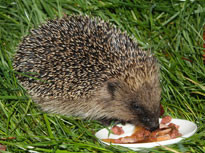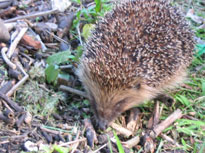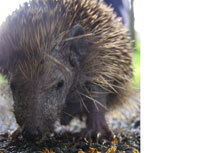Erinaceomorpha -- Prickly, Plump Pin-cushions



Origins
Erinaceidae(erinaceous is latin for hedgehog) is the only living family in the order of the Erinaceomorpha. A few years ago, before more heed was paid to molecular genetics, this order was clubbed in with shrews and moles, and was labeled insectivora. Now, there is a bit of clarity and we can see that these creatures, though they resembles shrews are distinct from them. I always thought the spines were a dead giveaway. It contains the well-known hedgehogs (subfamily Erinaceinae) of Eurasia and Africa and the gymnures or moonrats (subfamily Galericinae) of South-east Asia.
Erinaceids are a relatively primitive group of mammals, having changed little since their origin in the Eocene. The so-called 'giant hedgehog' (actually a gymnure) Deinogalerix, from the Miocene of Italy, was the size of a large rabbit, and may have eaten vertebrate prey or carrion, rather than insects.
What are they like?
Erinaceids look like shrews, with long snouts and short tails but they are much larger in size. Hedgehogs have a unique defensive adaptation in that they possess hair modified into sharp spines to form a protective covering over the upper body and flanks. All species have anal scent glands, but these are far better developed in gymnures, which can have a powerful odor(this is a polite way of saying that they stink to high heaven!).
Hedgehogs are sometimes confused with porcupines. However, there are crucial differences. Porcupine quills are actually offensive weapons and have barbs in them. Many a tiger has rued the day it got a hankering for porcupine meat. Porcupines are larger and belong among rodents, with their ever-growing teeth. Hedgehog are gentler and are routinely kept as pets.
Geographic Distribution
View Larger Map
Reproduction
Erinaceids are solitary animals outside the breeding season, and the father plays no role in raising the young. Female erinaceids give birth after a pregnancy of around six to seven weeks. The young are born blind and hairless, although hedgehogs begin to sprout their spines within 36 hours of birth.
Feeding Habits
Erinaceids are omnivorous, with the major part of their diet consisting of insects, earthworms, and other small invertebrates. They also eat seeds and fruit, and occasionally bird's eggs, along with any carrion they come across. Their teeth are sharp and suited for impaling invertebrate prey.
Families within Erinaceomorpha
Erinaceidae (Hedgehogs)
Amphilemuridae (AmphiLemurs EXTINCT!)
Videos